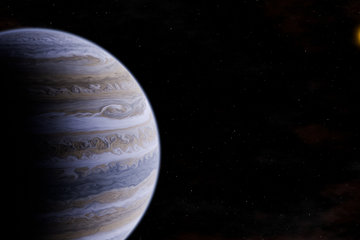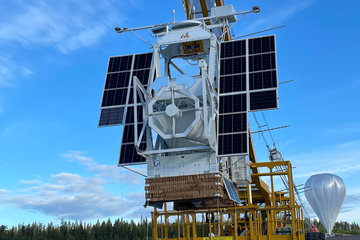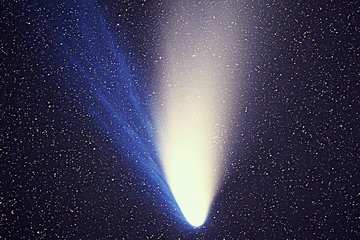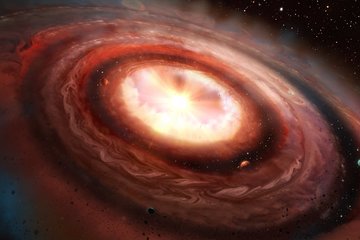The warped ways of cosmic light
Albert Einstein predicted them, modern giant telescopes detected them – and Klaus Dolag simulates them on a computer: gravitational lenses. The academic staff member at the Max Planck Institute for Astrophysics in Garching and at the University Observatory Munich uses this physical phenomenon to such ends as weighing galaxy clusters and probing that ominous substance known as dark matter.
Text: Helmut Hornung

The sky over Principe was cloudy and the mood in the camp on the coconut plantation had hit rock bottom. Having set out from England, the men had been traveling for weeks to reach the volcanic island in the Gulf of Guinea. Their goal: to write scientific history. They wanted nothing less than to prove a bold theory that a German physicist by the name of Albert Einstein had recently published. According to this theory, the gravity of a massive object should bend space, similar to the indentation made by a lead ball on a rubber blanket. If a marble is then rolled towards the ball, the marble will deviate from its originally straight course and, depending on its initial velocity, follow a more or less curved path. On this day, May 29, 1919, it would be possible to test this prediction of Einstein’s general theory of relativity on the island of Principe. And then the weather turned out to be miserable!
But the expedition led by astronomer Arthur Stanley Eddington had neither a blanket nor a ball with them, but rather a telescope and camera. The researchers wanted to use these to record a total eclipse of the Sun. The test was simple: if a massive object bends space, then the Sun must also cause the passing light from stars to deviate from its straight course. In other words, the points of light in the immediate vicinity of the black Sun should be shifted ever so slightly with respect to their true position in the sky. To check this, Eddington had recorded the star field six months earlier without any interference from the Sun, using the same instruments that he now aimed impatiently at the cloud-covered, slowly darkening Sun.
Virtual telescopes peer into space
And the astronomer was rewarded for his perseverance. During totality, the clouds parted for a few moments and Eddington managed to capture two images. “Lights All Askew in the Heavens” appeared on the front page of the New York Times on November 10, 1919. The “shifted lights in the sky” proved that the general relativity theory was correct – and established Albert Einstein as a legend.

More recent analyses of Eddington’s findings show that the values measured at that time did, indeed, correspond to the prediction, but that they are apparently the result of an instrument error of, as it so happens, the very same magnitude. But the gravitational effect has since been measured many times and perfectly confirmed – not a doubt remains. So Klaus Dolag doesn’t have to concern himself with evidence of any sort. He simply works with the effect – and applies the physical principle to weigh galaxy clusters or to track down the hidden matter in the universe. Moreover, the staff member at the Max Planck Institute for Astrophysics and at the University Observatory Munich doesn’t even need a cloudless sky: Klaus Dolag does his research with computer simulations, creating virtual telescopes.
To understand this, let us take another detour through history. Because the Sun bends the path of starlight, Albert Einstein had speculated in the journal Science in 1936 that a star could diffract the light from an object behind it – which propagates in a straight line in empty space – similar to a glass lens. In this way, the light from this object should be amplified, much like the Sun’s rays passing through a magnifying glass; and furthermore, multiple images of one and the same object might be created.
Einstein himself didn’t believe it could be proven
In 1937, Swiss astronomer Fritz Zwicky introduced the possibility of a galaxy acting as a lens that creates distorted images of more distant galaxy systems lying beyond it. Different images are created depending on the spatial orientation of observer, lens and object. If all three lie exactly in a line (the optical axis), a ring is formed. If they lie to one side of the optical axis, the images of the background sources appear as more or less strongly curved arcs. It is not just individual objects such as galaxies that act as lenses, but frequently galaxy clusters – accumulations of enormous concentrations of matter that we observe as many, relatively tightly clustered galaxy systems.

Regarding the practical proof of the gravitational lensing effect, Albert Einstein remained skeptical. He said that the effect – and especially the ring that was named after him – was too small: “Of course we have no hope of observing the phenomenon directly.” In 1979, researchers discovered the first quasar whose light was split off into multiple images by the gravitational field of a galaxy lying on the line of sight with the Earth. Quasars are the active cores of young galaxies. Driven by massive black holes, they have a very high energy output.
The type and shape of the lensed images follow the laws of optics and gravitation. Thus, similar to classical optics, it is possible to draw important conclusions from the cosmic images, about, for instance, the lens material or the composition of the medium – that is, about how mass is distributed within the galaxies, or the structure of the space. Galaxy clusters are particularly interesting for researchers like Klaus Dolag: “They are the largest systems in the universe that are bound together by gravity. That is why they have especially marked gravitational lensing effects.” This also explains why they benefit science in so many ways. And just what is the benefit?
Take, for example, the galaxy cluster Abell 2218, which is some two billion light-years away in the constellation Draco. On images from large telescopes, dozens of small arcs in different colors and shapes tell of galaxies that lie more than six billion light-years beyond Abell 2218 and that, without its effect, wouldn’t be visible at all. In short, gravitational lenses act as natural telescopes. The powerful magnifying effect of the Abell 1689 cluster led, for instance, to the discovery of one of the most distant galaxies known to date. We see it today in the light it emitted 700 million years after the Big Bang.
Time machines show the development of the galaxies
Because the speed of light is finite, the observation of distant objects is simultaneously a journey back in time. The universe has changed significantly since its birth 13.7 billion years ago. The galaxies, for example, have since developed in a certain way. Because telescopes (and gravitational lenses) act like time machines, they offer astronomers outstanding insights into the evolution of space.
In the case of Abell 2218, massive elliptical galaxies crowd together in the center; photos show, a bit outside of the middle, a further small cluster core. Apparently two galaxy clusters are merging together. This fact alone is an important indication for astronomers that such mergers shape the appearance of space. It seems that a particularly large amount of luminous arcs appear when the gravitational lens is composed of two merging clusters. This gives the researchers insight into the structural formation of the universe.
This aspect is of great importance: “One of the things cosmology has to explain is why, after the Big Bang, such things as galaxies and extended galaxy clusters in which stars and planets agglomerated emerged from what was originally quite an even distribution of matter,” says Klaus Dolag. Dark matter, which makes up some 23 percent of the universe, plays an important role here. The nature of this mysterious substance is literally in the dark.
Inflation is driving the universe apart
As mentioned, the images also contain information about the cluster acting as a lens. For example, it quickly becomes apparent that the visible mass contained in galaxies is not even close to being sufficient to hold together such a gigantic cluster as Abell 2218, with its several hundred members. Furthermore, the visible matter is not nearly adequate to produce the multiple arc-shaped images of the objects lying beyond it. After all, the optical properties of a gravitational lens are determined by its surface density.

Conversely, the astronomers can draw conclusions about the distribution of the masses within a gravitational lens, and distinguish the invisible and visible components from one another. “Gravitational lenses are the only direct method for determining the proportion of dark matter,” says Dolag.
And finally, gravitational lenses are precise tools for decoding the geometry of the cosmos. In the standard model, space was born with a “bang” 13.7 billion years ago. Scientists prefer to call this a singularity that can’t even be described with physical laws. According to the model, at the age of 10-35 seconds, the cosmos expanded by 50 orders of magnitude, from the diameter of a proton to that of an orange. That moment, known as inflation, increased the bubbling in the quantum soup to macroscopic dimensions. These structures are visible in the baby photos of space, in the light of microwaves, as color-coded spots having minimally different temperatures; they were emitted 380,000 years after the Big Bang and are being picked up today by satellites such as WMAP and Planck.
The universe has been expanding since inflation, but for the past approximately five billion years, the rate has been much faster than expected. The mysterious driving force acts furtively and makes up around 73 percent of the energy density of space. A disturbing concept: 73 percent dark energy, 23 percent dark matter – the cosmos is made up primarily of an unknown substance. Baryonic matter – making up our old familiar protons, neutrons and electrons – accounts for just 4 percent; we see only this tiny portion with the naked eye or with telescopes, as planets and stars, gaseous nebula and galaxies.
A network of intricate fibers emerges on the computer
The researchers describe the universe as a whole using a set of parameters that characterize the amount of energy and matter, the density and the expansion rate. A further key value is the cosmological constant, a form of time-invariant dark energy. In the department of Director Simon White, a group at the Max Planck Institute for Astrophysics is using the ingredients mentioned above to create the universe on a computer. To do this, the cosmologists start a few hundred thousand years after the Big Bang and watch how, over time, the computer spins a network of intricate fibers and pearl-like bulges, the seeds of galaxies.

Klaus Dolag uses simulations, too. That is, he uses computer programs to build gravitational lenses. To do this, he takes not only masses and density fields into account, but also dark matter and baryonic gas. From these ingredients, his software reconstructs the development of large-scale structures and the evolution of galaxies. Dolag’s colleagues use a similar approach, for example in their famous millennium simulation. There, to a virtual cube of space having a side length of 2.1 billion light-years, they added no fewer than ten trillion solar masses of dark matter, spread among ten billion units of virtual matter.
“Our simulations use even more physics,” says Klaus Dolag. “Because we also take baryonic matter into account, we can simulate the appearance of galaxies and galaxy clusters in various wavelength ranges, such as in X-ray light.” The artificial cosmos is formed from essentially two layers: a few hundred to a thousand foreground galaxies and countless background galaxies distributed according to a model that corresponds to nature. Superimposing the two layers on the computer yields an image of a virtual section of sky.
The lens structure influences the images
Because the foreground galaxies act as a gravitational lens, they influence the images of the background galaxies; their shape depends on the structure of the lens. In this way, Dolag obtains a virtual gravitational lens that can be played with. He can then study how the images change, for example when more or less mass is assumed, or the distances between the galaxies are changed.

Klaus Dolag shows images of his simulations, which seem so deceptively real that a layperson can’t even distinguish them from images taken with large telescopes. In fact, the programs also include instrument data: the diameter of the telescope mirror, spectral ranges and filter properties, and exposure times for the images.
All this effort is not an end in itself. One group, of which Klaus Dolag was also a member, simulated observations of a galaxy field such as might one day be possible with the space telescope Euclid planned by the European space agency ESA. One of the scientists’ aims was to measure arcs – their length, thickness and curvature. It was hoped that these virtual gravitational lensing effects would offer valuable information about the effects actually observed in space.
“We found interesting connections,” says Dolag. “For example, the length-to-width ratio of the arcs is a good indicator and permits conclusions about the distribution of mass in a gravitational lens.” The simulations also showed that observation effects can influence the measurement of the arcs. Dolag says: “We will have to take that into account when interpreting future observations.”

So it’s about testing models on reality. Or comparing different measurement methods with each other. In an essay that recently appeared in the journal Astronomy & Astrophysics, Klaus Dolag and his colleagues address the issue of determining the mass of galaxy clusters. There are two main options available: gravitational lenses and X-ray observations. The latter are based on the fact that, between the galaxies in a cluster, there is hot gas that emits X-rays. The observations can be used to create a mass profile of the galaxy cluster – assuming that the distribution of the intergalactic gas can be described with simple models and that it is in hydrostatic balance – in other words, gravity keeps it in form.
Errors increase near the edge of the cluster
“In practice, there are problems, since there are often discrepancies between the results of the two methods,” says Dolag. Therefore his team created three galaxy clusters and first simulated observations with an artificial X-ray telescope and then images with a gravitational lens. In the center of the cluster, strong lensing effects appeared that made it possible to determine the mass fairly precisely. However, extrapolating from the measurements near the edges of the cluster, where weak lens effects appeared, led to relatively large errors.

Furthermore, with weak lensing effects, the measurements worked best when the masses in the lensing galaxy clusters were distributed evenly; the more “streaks” there were in the lenses, the larger the errors became. Also, the true structure of the galaxy clusters in space – in other words, their shape in all three dimensions – likewise influenced the results; for instance, the mass of a lens is generally overestimated when its optical axis points directly toward the observer. “Using such simulations, we test how the models for describing the distribution of matter in gravitational lenses need to be improved in order to approximate reality as closely as possible,” says Klaus Dolag.
But, thanks to their simulations, the researchers also found a few error sources in the X-ray observations. If, for example, the gas between the galaxies was not exactly in the aforementioned hydrostatic balance, then the results deviated from reality by as much as 20 percent.
“Comparing the two methods on a case-by-case basis is indeed rather complicated. Nevertheless, observing many clusters will give us valuable clues about the physics of the gas between the galaxies. Not least, we should be able to calibrate the X-ray measurements based on the results from gravitational lensing effects,” says Klaus Dolag, summarizing the outcome of their work.
Cosmic zoom on distant objects
The more closely the astronomers scan the universe with their telescopes, the more gravitational lenses they find. Special search programs like the Cosmic Evolution Survey (COSMOS) and the Sloan Lens ACS Survey (SLACS) are uncovering dozens of new objects for the scientists. These also find such exotic specimens as the three different colored arcs that are grouped around a galaxy; in this system, it is possible that two lenses are acting together and zooming in to the image of an immensely distant galaxy. This would allow the astronomers to glimpse that much further back into the past.
In parallel with improving the detection methods, scientists such as Klaus Dolag are fine-tuning their simulations. The more exact their computer reproductions of the cosmos are, the more accurate their statements about the evolution of the galaxies and the development of the universe as a whole will become. Even now, the physics of gravitational lenses is showing initial approaches to examining different models and testing cosmological parameters. Although the researchers don’t have to travel to exotic locations as they did in 1929 to make big discoveries, exploring space is still an adventure – even if doing so requires only the right algorithms and fast computers.
Glossary
Cosmological constant
A positive constant introduced by Albert Einstein (1879 to 1955) in his gravitational field equations to prevent the contraction of the universe due to gravitational attraction. In 1998, L (lambda) experienced a renaissance when the rapid expansion of space was discovered. It is still not clear what causes L.
Millennium simulation
Researchers use supercomputers to investigate the question of how today’s galaxies and stars were able to form from what was, directly after the Big Bang, a formless universe. With the appropriate ingredients, such as dark matter, the simulation does indeed show the emergence of major irregularities when small manipulations are introduced. Cosmologists from Germany, the UK, Canada, Japan and the US are participating in the project, which is being led by the Max Planck Institute for Astrophysics.
Planck
The European probe that was launched in May 2009 together with the infrared Herschel observatory is expected to closely examine the cosmic microwave background, but with much greater precision than WMAP. The first complete image of the sky was published in summer 2010.
WMAP
The US satellite Wilkinson Microwave Anisotropy Probe was launched in 2001 and transmitted data to the Earth up until a few months ago. The aim of the mission was to investigate cosmic background radiation, and especially irregularities stemming from large-scale cosmic structures. The famous WMAP map shows the universe as it appeared 380,000 years after its birth.



















